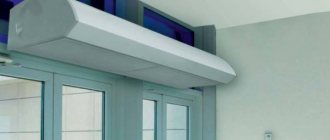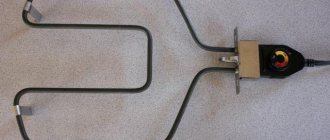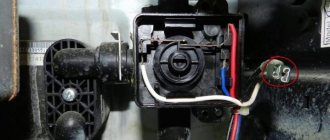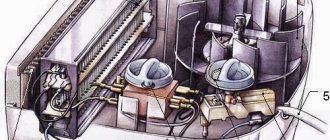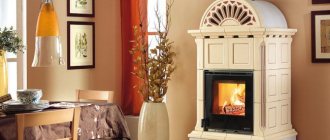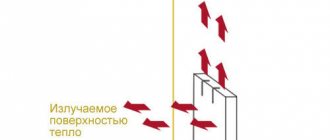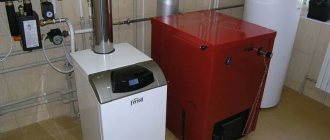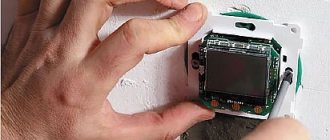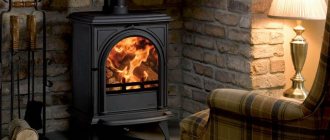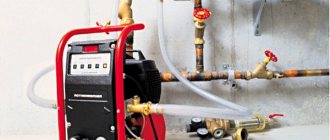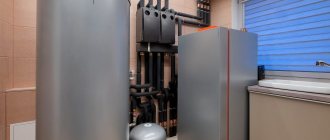An electric heated towel rail is a device used for quick and comfortable drying of towels. In addition, in the bathroom it can also be used as a heating device. Before purchasing such equipment, it is recommended to find out how many watts an electric heated towel rail consumes and which model is best to choose.
Are there GOST standards regulating energy consumption of equipment?
According to GOST R 51617-2000, during the heating season the temperature in the bathroom should be +25°C. If the room is small, then a heated towel rail with an electric water heater can handle its heating. When choosing it, it is necessary to take into account that the power corresponds to the area of the heated room.
In order for this device to heat a room, a minimum of 100 W is needed per 1 m². Taking into account the fact that the equipment should not work to wear out, i.e. at its maximum capabilities, it is recommended to take its power into account with a reserve. 140 W per 1 m² is considered optimal.
In this case, the device will be able to heat the bathroom well, while the electricity consumption will be small.
Incorrect formulas
Cost optimization is ensured by thermal engineering calculations. Battery manufacturers, followed by copywriters, offer calculation methods:
- By area:
Q = q F, (3)
where q – specific heat flow, W/m²;
F – room area, m².
Everywhere appears q = 100 W/m², less often – q = 140 W/m².
- By volume:
Q = qv V, (4)
where qv – specific heat flow, W/m³;
V – room volume, m³.
They give qv = 20, 34, 41 W/m³ - large numbers with worse thermal insulation of the walls.
Reliability is supported by reference to SNiP. Attention! Canceled and existing joint ventures on building heating engineering, thermal protection, residential buildings, heating and ventilation do not contain the specified data .
Documentation:
https://docs.cntd.ru/document/871001234;
https://docs.cntd.ru/document/1200035109;
https://docs.cntd.ru/document/1200035579.
The authors copy from each other without bothering to check. Think about it: are the heat losses in a panel “Khrushchev” building identical to those in a brick house insulated with basalt? The difference between 20 and 41 W/m³ - answers the question, but how to take into account the temperature on the street (Crimea not Krasnoyarsk), the number of external walls?
The formula is intended to dispel doubts:
Q = q F K1 K2 K2 K3 K4 K5 K6 K7, (5)
where Ki are coefficients that take into account, respectively: glazing characteristics, degree of thermal insulation, ratio of window area to floor, average temperature in the coldest week of the year, number of external walls, type of upper and lower rooms, ceiling height.
Credibility is emphasized by such normative amendments. Someone “modified” the expression, but the previous value of q (0.1 kW per square meter) refutes its authenticity. In addition, the more clarifying multipliers, the more “floating” the result is.
To confirm this, let us calculate from dependencies (3), (4) the required heating power for a bathtub with a height of 2.5 m:
Identical results in two columns, the difference in others reaches two times. The discrepancies will increase with increasing altitude.
Design features of electric dryers
The design of a modern heated towel rail will depend on the type of heating mechanism used in it. Depending on this, such equipment is:
- liquid;
- dry;
- hybrid.
Any electric heated towel rail consists of a body, a heating element and a power cord. In the liquid version, great importance is given to sealing the housing, because There is a coolant inside (oil or antifreeze). If heating occurs due to the cable, then it is placed in a graphite gasket.
The best option is a 2-circuit design. Here, one circuit of the device is powered by electricity, and the second by a hot water supply system. During the heating season, the heated towel rail operates using hot water supply, and in the warm season - from the mains.
Constructions
All heated towel rails can be divided into three large groups:
- classic shape;
- ladder;
- designer
An electric heated towel rail with a classic shape - not too complex designs such as C-shaped, U- and M-shaped, S-shaped, snake or zigzag. Such forms appeared first; they were made by bending the riser pipe. Modern designers combine them to create interesting models. But even the simplest in shape - just racks of one or two pipes - look very non-trivial in a suitable interior.
Even traditional shapes can be interesting
Ladders are a more complex design of heated towel rails. They consist of one or more racks, which are connected by a number of jumpers. The jumpers can be hollow inside (tubes), a cable can be laid in them, and coolant (water, oil) can flow. But they are also made simply from metal plates - increasing the heat transfer area.
You can always find something interesting
Designer models of electric heated towel rails can be very unusual. Some build a mirror into them, some make them in the form of a variety of shapes. You can even find them in the form of animals, fish, flowers. This is primarily a decoration. It is unlikely that you will dry your clothes on such a device.
What affects electricity consumption
The energy consumption of a heated towel rail mainly depends on the type of heating element used. In addition, the dimensions of the device are also important; the larger they are, the more powerful the equipment and the more electricity it consumes.
The thermal cord ensures rapid heating of the device and consumes less energy, but after disconnecting from the network, the heated towel rail quickly cools down. The heating element has more power, therefore the energy consumption is higher. The device takes a long time to heat up, but after switching off it retains heat well.
It is also important that the device contains a thermostat, which allows you to set the required heating temperature, as well as a timer, with which you can set the operating mode.
Device with heating element
Depending on the model, the power of the heating element or insulated heating cable ranges from 300 W to 2 kW. Such devices use a coolant liquid:
- distilled water;
- antifreeze;
- mineral oil.
The last option provides maximum heat capacity; such heated towel rails heat up more slowly, but take a long time to cool down. The type and volume of coolant matter. This indicator directly affects the characteristics of the device.
The installation of such a device is carried out so that the heating element is at the bottom. Switching on and off the equipment is controlled by thermal sensors, so the main energy consumption occurs during warm-up. After this, the set temperature is only maintained, so electricity consumption is small.
Heated towel rail with cable
The principle of operation of such equipment is similar to how a “warm floor” works. A heating cable placed in a graphite sheath is installed inside the body of the heated towel rail, and when current passes through it, the device heats up. Thanks to this, almost instantaneous heating of the entire surface of the device occurs, but after the power supply stops, the heated towel rail quickly cools down.
Devices with a cable last longer than liquid models. This is due to the fact that the heating element operates in a dry environment and the thermal cord can heat up to +90°C, and the heating temperature of the heated towel rail is limited to +60°C.
Such devices have a power ranging from 30-165 W. This ensures their higher efficiency, but their heat transfer will be lower. Devices with a heating cord are suitable for drying towels or underwear, but it is irrational to use them to heat a room.
What is the body made of?
An electric heated towel rail can be made from a square/rectangular, oval or round pipe. In order for the “towel” to serve for a long time, the thickness of the pipe wall must be at least 2 mm. Then the welds will be reliable.
If we talk about appearance, then products made from profiled pipes (rectangular or square cross-section) look more decorative and unusual. Models in a modern style are made from this material; they are also suitable for interiors in the style of minimalism and hi-tech. In such cases, the place for them is chosen “in plain sight”, and they serve more for decoration.
Various styles and options
You don’t always want to attract attention to a heated towel rail. In this case, round pipes are ideal, and even painted in a neutral color (white, gray) or the color of the walls. Most often, ordinary steel is painted, but many manufacturers can also paint stainless steel to order. There are practically no painted brass or copper models. They are a decoration in themselves. And they buy them precisely for their bright and memorable appearance.
An electric heated towel rail can be made from:
- black (structural) steel;
- of stainless steel;
- copper and its alloys - brass, bronze.
The most inexpensive option is structural steel. The inside is coated with an anti-corrosion compound, and paint or a layer of spraying (chrome plating, nickel plating) is applied on top. Such models are mainly made of the “dry” type - with a cable or a dry heating element. But there is also a liquid type.
More traditional forms - different types of “ladders”
Stainless steel products are more durable. They can last 10 years or more. But subject to mandatory grounding (to eliminate the possibility of electrocorrosion). Some manufacturers suggest covering the inside of the pipes with a layer of polymer (Sunerzha) to prevent corrosion. A good solution, but it raises the price significantly. But the service life is longer.
Some consider copper or brass electric heated towel rails to be the most decorative. One can argue here, but there really are interesting models. True, the price is completely immodest. If we talk about practical aspects - caring for a heated towel rail - then it is the copper and brass ones that require the greatest and most careful care. Their surface must be polished regularly using special products. Otherwise, in conditions of high humidity, it becomes very unsightly.
Official energy consumption ratio
Energy consumption coefficient is the ratio of the entire period of operation of the device to the time of its active heating, when maximum energy is consumed. This indicator is close to the concept of efficiency. The better the device retains and longer releases the heat obtained by heating with electricity, the less energy it consumes and the lower the coefficient.
For household heated towel rails, this figure ranges from 0.4 (24 minutes of energy consumption) to 0.16 (10 minutes). It is influenced by the design of the appliance, as well as how much laundry is dried and how wet it is.
If the device is also used to heat the room, then the value also depends on the proportion of the equipment’s power to the air exchange of the ventilation system.
Tera Victoria 500x800 E
Main characteristics:
- Material: stainless steel;
- Power - 105 W;
- Maximum heating temperature - 50°C;
- Possibility of rotation - no;
- Dimensions - 80x50 cm.
Design and material of manufacture. This domestic electric “dry” type heated towel rail has the appearance of a modified ladder with five rungs slightly protruding outward. It is made of durable stainless steel pipes with a chrome-plated outer surface. For rigid mounting to the wall, 4 brackets are used. The product weighs almost 7 kg and occupies an area of 500x800 mm.
Parameters and connection. The device consumes electricity in the amount of 105 W. It is designed for open connection using a standard power cable and plug. There is an on/off button.
How to calculate monthly consumption rate
To calculate the electricity consumption of a heated towel rail per month, the value of its power and the demand factor are taken from the device’s passport (for such devices it is taken equal to 0.4).
The calculation is performed using the following formula: EE = P * K * T, where:
- EE—electricity costs;
- P—device power;
- T is the time it works during the day.
If a heated towel rail with a power of 500 W is installed and it works for 4 hours per day, then 500x0.4x4 = 800 W, i.e. per month you get 24 kW.
In 2011, a study was conducted in which heated towel rails with a power of 300 and 600 W were tested. Both devices were set to maintain a surface temperature of +45°C for 3 days. The result was:
- A 300-watt device consumed 9.6 kW;
- 600-watt - 6.9 kW.
Such indicators are explained by the fact that less powerful equipment for heating the coolant to a given temperature worked at maximum load, and therefore spent more energy.
A more powerful heating element quickly heated the heated towel rail to the desired temperature, and then only turned on periodically to maintain it within the specified limits.
Heat loss calculation
Basic
Heat losses from bathroom enclosing structures are calculated element by element Qi, W:
Losses are not taken into account:
- Through internal partitions when the temperature difference between adjacent rooms is less than 5ºC.
- Through ceilings with heated floors.
A bathroom can have up to 2 external walls; cold attic, underground, in which the following is determined:
- Square.
- Heat transfer resistance Ro according to SNiP 23-02-2003 (SNiP II-3-79).
- Temperature difference (tv = 24 °C).
Knowing the brands and thickness of the structures, you can roughly assume the characteristics by analogy.
Thermal calculator
It is convenient to calculate heat transfer resistance in the program:
https://www.smartcalc.ru/thermocalc?&gp=212&rt=0&ct=0&os=0&ti=20&to=-10&hi=55&ho=85
Example.
Bathroom 2.3 × 1.85 m, height – 2.5 m; adjacent to the heated staircase (tn = 16 °C), partitions made of plastered foam concrete 200 mm thick.
Define: Ro, ∑Qi.
Algorithm:
- Set the region.
- We choose: type of room - bathroom, structure - wall.
- We insert the layers of the structure: plaster – foam concrete – plaster. Specify the thickness.
- We accept climatic parameters outside and indoors, taking into account the sign.
- We analyze the results in the tabs: thermal protection, thermal losses.
Further calculation in the table:
We do not take into account the influence of wind and sun on internal partitions.
Video on how SmartCalc works:
Ventilation, general
We determine the cost of heating the supply air Qvent, W:
tн = 20 °C – inflow mainly from rooms, non-residential infiltration is neglected.
Qvent = 0.28 × 25 × 1.2 × 1 × (24 − 20) × 1 = 34 W
Total losses (2):
Q∑ = 67 + 34 = 101 W
What power of heated towel rail should you choose for your needs?
If the device will only be used for drying towels and clothes, then its power of 35 W/m² is sufficient. If it is also used for heating a bathroom, you will need 140 W/m². This will be enough to maintain a room temperature of +25°C during the heating season.
If you install a heated towel rail with a lower power, it will not be able to heat the air to the required temperature and, at the same time, the electricity consumption will be greater. A device that is too powerful should not be installed. Due to the thermostat, electricity consumption will not increase, but turning it on/off frequently will lead to a reduction in service life.
Calculation example
In most multi-storey buildings, the bathroom area is from 3 to 5 m², although in private buildings it can be up to 10 m² or more. When choosing a heated towel rail, the best option is 140 W per m², i.e. for a bathroom with an area of 4 m² you will need a 560 W device.
You can always choose a model whose power corresponds to the area of the room. A deviation of the power indicator by 20-30 W is considered insignificant and does not affect the operation of the device.
When choosing a heated towel rail only for drying clothes, the given parameters are not followed. In this case, the main attention is paid to the dimensions of the device so that the towels of all family members fit on it.
Comparison with a water heated towel rail
Water models are connected to a heating or hot water system. Hot water circulates inside them, thereby heating the surface of the device. When choosing such models, pay attention to its dimensions, as well as the pressure for which it is designed, the optimal indicator is 7-10 atm.
The main disadvantage of a water appliance is that it only functions when hot water is supplied. If it is turned off in the summer, then the heated towel rail does not work either. If the temperature of the water model cannot be adjusted, then many electric options have the ability to set its value.
The best Russian and foreign manufacturers
The heated towel rail market is diverse: you can find models of any quality, design, price, so you should pay special attention to the brand and reputation of the manufacturer. Let's consider which electric heated towel rails our compatriots consider the best.
The Italian company Margaroli produces models with power from 100 to 300 W. All of them are distinguished by a thoughtful design and increased comfort in operation.
Best manufacturers:
- Kermi. Kermi heated towel rails are truly German quality and Swiss reliability. The Kermi brand has been known on the market for more than half a century and is already considered legendary. The main advantage of this brand’s equipment is its reasonable price-quality ratio. Heated towel rails are made of good steel, mainly in the shape of a ladder. They are durable, reliable, and stylistically neutral.
- Arbonia. Designer radiators and heated towel rails from the Swiss company Arbonia are an expensive pleasure, but the quality and appearance of the products are beyond praise. Models are made of steel. Antifreeze is used as a coolant for combined heated towel rails. It is possible to manually adjust the heating temperature.
- Margaroli . Italian appliances from the Margaroli brand are not affordable for everyone. Heated towel rails of this brand are made of high-quality expensive materials and equipped with automatic equipment. There are devices made of brass. Distinctive features of Margaroli equipment are exquisite design and durability. The manufacturer is so confident in the quality of the product that it provides a 15-year guarantee.
- Energy . Energy Group is one of the leaders in the European heating equipment market. The manufacturer produces durable, high-quality devices. Any design: the range includes flat, three-dimensional, rotary models of various configurations. The Energy U G3K heated towel rail is especially popular because... combines good technical characteristics and reasonable price.
- "Sunerja". The Russian company produces elite models of heated towel rails, which are in demand not only in the domestic but also in the European market. The models are varied in design, made of stainless steel with a durable shiny coating. The warranty for Sunerge products is 5 years.
- "Dvin". The Russian company has produced more than 30 series of heated towel rails made of polished stainless steel. Most of the models are made in the form of a ladder. The manufacturer provides a 1 year warranty on its products.
- "Nika". Electric heated towel rails of the Nika brand have been known on the market for more than 10 years. Buyers value branded products for their good quality and stylish design. The company does not produce rotating models, but there are many interesting heated towel rails with shelves. The warranty on this company's products is 5 years.
- Terminus. The main advantage of heated towel rails of the Russian brand Terminus is a wide selection of models. Among them there are both budget and expensive ones. The heated towel rails are made of 2 mm thick steel. The models are distinguished by high performance characteristics and stylish design. The manufacturer provides a 10-year warranty.
- "Leader-Steel". Many buyers prefer products. The heated towel rails are made of stainless steel, the heating temperature can be adjusted from 30 to 70 degrees. In case of overheating or hypothermia, the devices turn off automatically. The manufacturer provides a 5-year warranty.
- Terma . The Polish company Terma has been known on the market for more than a quarter of a century. During this time, it gained popularity among our compatriots.
Terma heated towel rails are made of high quality steel and equipped with thermostats.
A number of manufacturers produce, in addition to electric, water and combined models.
Terminus brand models are made in Russia: the manufacturer uses high-quality imported materials, in particular Italian stainless steel
Tips for reducing energy costs
To reduce energy costs as much as possible, you need to purchase equipment that has energy-saving components.
Installing a thermostat
Many models have a temperature sensor and regulator installed at once. They are installed only on liquid models with heating elements. Cable heated towel rails do not have a thermostat, because... their maximum heating temperature is +60°C.
Using models with a timer
It is convenient when such a device is additionally equipped with a timer. With its help, you set the time to turn on the device, and it will automatically turn on and off. This allows additional energy savings.
External signs of normal quality
Something else worth paying attention to is the quality of the seams. The first sign of a high-quality seam is that it is smooth and uniform. Without cavities, strong protrusions and depressions. If you pre-select a manufacturer, find information about exactly how, on what equipment, and in what environment welding takes place. This is especially critical for stainless steel. It must be cooked in a protective (usually argon) environment so that the alloying metals do not burn out. If you weld stainless steel using the usual method, in an atmosphere with oxygen, the “stainless” properties in the weld area are not preserved. Then it is the seam that begins to rust and leak. Therefore, manufacturers usually indicate exactly how stainless steel is welded.
There are models with folding parts
It is also worth paying attention to the quality of painting, chrome plating, and nickel plating. There should be no defects, unpainted areas, or foreign inclusions. Only if all these conditions are met can you think about buying.
Should you use a heated towel rail to heat your bathroom?
A heated towel rail can be the main source of heat in the bathroom of a multi-storey building. Here this room is surrounded on all sides by other warm rooms, so the power of such a device is sufficient for heating. In private homes, the bathroom walls are often external, so heat loss is greater. In such cases, only a heated towel rail for heating may not be enough, then it is used as an additional source of heat.
If this device will be the main source of heat in the bathroom, then its thermal power should be in the range of 100-140 W/m², then it will cope with the task.
Instal-Projekt SPINA ELECTRO 550×625
Main characteristics:
- Material: steel;
- Power - 115 W;
- Maximum heating temperature - 95°C;
- Possibility of rotation - 90°;
- Dimensions - 104.5x40x5.5 cm.
Design and material of manufacture. The “dry” type heated towel rail weighs 3 kg and has dimensions of 625x550x8.5 cm. It is a combination of a vertical tube and an W-shaped coil. It can be mounted along the wall or used as a rotating model. All parts are made of easy-to-maintain chrome-plated stainless steel.
Parameters and connection. The product consumes 90 W of power sufficient to dry towels. It is connected to the power source externally using a twisted cable with a standard plug at the end.
Low power models
Many manufacturers offer heated towel rails with low energy consumption. This is achieved not due to the low power of the device, but due to the high level of energy saving. A low-power device does not always help save money. Low-power heated towel rails are only suitable for small bathrooms that have basic heating.
To ensure that the equipment does not constantly work at the limit of its capabilities, it must be purchased with a power reserve. Popular manufacturers of heated towel rails with low energy consumption: Sunerzha, Terminus, Arbonia, Devon, etc.
A modern heated towel rail does its job well and looks beautiful, so it fits seamlessly into the design. After installing such a device, you can forget about the dampness and unpleasant smell that often occur in the bathroom.
ENERGY I chrome G5
Main characteristics:
- Material: stainless steel;
- Power - 47 W;
- Maximum heating temperature - 60°C; Possibility of rotation - 180°;
- Dimensions - 55x64x99 cm.
Design and material of manufacture. The model of the famous British brand is a vertical stand 640 mm high with five horizontal bars 555 mm long rotating on it, each of which can occupy an independent position from the others. This allows you to save space or achieve better ventilation of drying items in different situations.
All parts are made of stainless steel and coated with chrome on the outside. The heating element is a heating cable laid inside the tubes. The degree of protection against dust and moisture corresponds to IP44. The product weighs only 1.9 kg and is attached to the wall with four dowels.
Parameters and connection. The heated towel rail consumes 47 W of electrical energy. Connection is possible in open and closed ways. The power switch is located at the lower end of the vertical stand and has a light indication.
Toggle switch ENERGY I chrome G5.
№2 – TERMINUS Sicily P12
Price: 17,000 rubles
A modern unit with an advanced frost protection system. In the event of a sharp drop in temperature, it will start on its own to prevent the coolant from freezing, so we do not recommend removing it from the outlet. Fortunately, there is a shutdown button, so you don’t have to do this. There are already 12 sections, of course, because of this, such a device is more suitable for placement in a bathhouse, but surely someone will find a use for it in everyday life.
The thermostat allows you to select one of four heating levels. Installation is simple; using the instructions, you can install the unit yourself. The only disadvantages include the lower right connection, as well as the narrow distance between the device and the wall, which makes throwing thick towels not very convenient.
Advantages of an electrical device
Here's what a person will benefit from after purchasing an electric heated towel rail for a room:
- eliminate leaks: if water models can leak, then the likelihood of such an outcome in an electric type is completely excluded;
- save: energy consumption is minimal and several times less if batteries or heaters were used;
- gain independence from utility systems: if you choose a water-based model, you can become dependent on utilities, which can change the water supply pressure.
However, you should not blindly follow all the advantages, because for some they actually are not such. First of all, you need to analyze the general position of the space and what is really needed for it. After all, if the bathroom already has a battery, then buying such a “dryer” is pointless.
Energy U chrome G2K 540×400
Main characteristics:
- Material: stainless steel;
- Power - 24 W;
- Maximum heating temperature - 60°C;
- Possibility of rotation - 180°;
- Dimensions - 54x40x9.9 cm.
Design and material of manufacture. This compact model consists of a vertical axis fixed along the wall and two U-shaped sections rotating relative to it. It is made of stainless steel, which guarantees long service life and resistance to mechanical stress. External surfaces are chrome plated for greater aesthetics. With dimensions of 54x40 cm, the product weighs only 1.3 kg, which simplifies installation. The heating element is a double insulated heating cable. Protection of live parts corresponds to class IP44.
Parameters and connection. The device is intended exclusively for drying things, so its power does not exceed 24 W. It is possible to connect in an open and closed way. The on/off switch is equipped with internal lighting, which is convenient in low light conditions.
Why do you need a thermostat?
Manufacturers of heated towel rails today offer several model options: from simple budget ones to those equipped with additional options for more convenient operation and saving energy consumption. The simplest option is when the unit operates at a constant temperature, that is, it heats up stably and operates in the same temperature range.
More structurally complex heated towel rails are equipped with special sensors that, when a certain temperature is reached, switch the devices into an energy-saving mode. Models of this type are quite expensive.
Complete set of electric heated towel rail with thermostat
An alternative option is an electric heated towel rail with a thermostat, which allows the user to independently set the temperature range. If you urgently need to dry your laundry or the room gets cold, you just need to set the device to maximum.
The rest of the time, the equipment will operate at minimum power, thereby significantly saving energy. An electric model with a thermostat will generally cost 5-10% more than a simple standard electric heated towel rail without additional options, but the difference in price will quickly pay for itself in ongoing savings on electricity bills.

